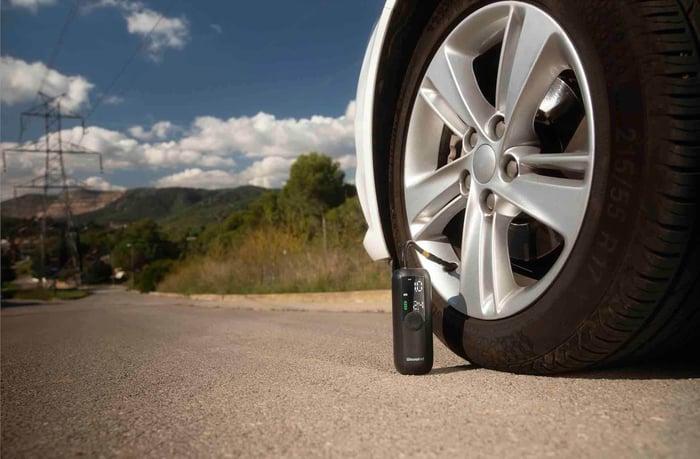
How to Fix a Slow Leak in a Car Tire: DIY Guide
Discovering a slow leak in your tire can be frustrating, but knowing how to fix a slow leak in a car tire empowers you to handle the situation quickly and safely. With the right tools, a little patience, and a reliable inflator like the Woowind LP1, you can get back on the road with confidence.
Table of Contents
How to Detect a Slow Leak Safely
Before you attempt repairs, you need to identify the source of the leak:
Visual Inspection: Look for nails, screws, or debris stuck in the tread.
Soapy Water Test: Mix soap and water in a spray bottle, spray it onto the tire (especially the tread, sidewall, and valve stem), and look for bubbles indicating air loss.
Listen Carefully: In a quiet area, you might hear a faint hissing sound from the leak.
Always check your spare tire’s condition while inspecting the damaged one—it might become necessary! To avoid surprises, learn how to check tire pressure correctly and consistently.
Essential Tools to Fix a Slow Tire Leak
Prepare the following:
Tire plug kit (reamer, insertion tool, rubber plugs)
Patch kit (for internal repairs)
Tire pressure gauge
Portable inflator (like the Woowind LP1)
Jack and wheel chocks
Secure your vehicle on flat ground with the emergency brake engaged before beginning any work. Browse our full Woowind car air pumps collection for portable options that simplify roadside repairs.

Step-by-Step Instructions for Patching or Plugging
1. Locate and Mark the Leak
Use chalk or a marker to clearly identify the puncture spot.
2. Remove the Debris
If a nail or screw is embedded, pull it out carefully using pliers.
3. Prepare the Hole
Insert the reamer tool into the hole and twist several times to clean and widen it for plug insertion.
4. Insert the Plug
Thread a rubber plug into the insertion tool, push it firmly into the hole, and then pull the tool out—leaving the plug behind.
5. Trim Excess Plug Material
Use a knife or scissors to trim the plug flush with the tread.
6. Inflate and Check
Use the Woowind LP1 to reinflate the tire to the recommended PSI. Spray soapy water again to verify the leak is fully sealed.
7. Monitor Over Time
Keep an eye on tire pressure over the next week to ensure the repair holds.
When to Patch and When to Replace a Tire
Patch or Plug If:
The puncture is in the tread area
The hole is less than 6mm in diameter
Replace the Tire If:
Damage is on the sidewall or shoulder
There are multiple punctures close together
The tire is older than 6 years or shows sidewall cracking
When in doubt, consult a professional tire shop to assess structural integrity. Remember, knowing how long tires last can help you decide between repair and replacement.
Reinflate Properly: Why Woowind LP1 Inflators Are Essential
After repairing a leak, restoring your tire to the correct PSI is crucial for safety and performance. The Woowind LP1 Electric Pump offers:
Precise digital PSI control to avoid over- or underinflation
Cordless operation with strong battery life—perfect for roadside emergencies
Powerful inflation that handles car tires efficiently within minutes
Compact and portable
For best results, check out the Woowind Electric Air Pumps collection to stay prepared.
Final Thoughts: Tackle Tire Leaks with Confidence
Understanding how to fix a slow leak in a car tire gives you peace of mind and saves you time and money. Whether you're patching a puncture yourself or using a professional for bigger issues, keeping a reliable inflator like the Woowind LP1 in your trunk ensures you’re always ready to hit the road safely.
FAQs
What causes a slow leak in a car tire?
Slow leaks are often caused by punctures from nails or debris, valve stem failures, or bead seal issues around the rim.
Can I drive with a slow leak? I
It's risky to drive with a slow leak. It can lead to underinflation, poor handling, and potential blowouts.
How do I know if a tire plug is holding?
After plugging, spray soapy water on the repair. If no bubbles form, the plug is holding.
How long will a plugged tire last?
A properly installed plug can last thousands of miles, but it's safer to have the tire professionally repaired or replaced soon.
Should I always replace a tire with sidewall damage?
Yes, sidewall damage cannot be safely repaired and requires full tire replacement.
Regular tire checks and prompt leak repairs will keep your adventures rolling smoothly!













